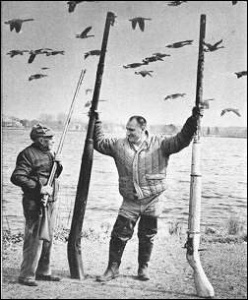Latest revision as of 15:55, 15 March 2013
| Punt Gun
|

|
| Dr. Freud to the ER, please; Dr. Freud to the ER...
|
|
| Type
|
bigass shotgun
|
| Land of Origin
|
uncertain, likely either Britain or the US
|
| Specifications
|
| Length
|
too damn long
|
| Weight
|
could be over 100lbs
|
| Gauge
|
.75... or larger!
|
| Cartridge
|
none
|
| Action
|
various, usually caplock
|
| Rifling/Twist
|
none (smoothbore)
|
|
| Rate of Fire
|
once every half hour, maybe
|
| Feed
|
muzzleloader
|
| Sights
|
none
|
| Production History
|
| Design Date
|
early 1800s
|
| Manufacturer
|
custom work by various gunworks and gunsmiths
|
| Produced
|
19th century to (very rarely) present
|
| Variants
|
uh... beehive artillery, maybe?
|
A punt gun is a ridonkulously bigass shotgun used in the 19th and early 20th centuries for shooting shitloads of waterfowl for commercial harvesting operations and, apparently, for private sport. (Just who the hell would sport-hunt with these things is not entirely clear.) Punt guns were usually custom-designed and so varied widely, but could have bore diameters exceeding 2 inches (51 mm) and fire over a pound (about .45 kg) of shot at a time.[1] A single shot could kill over 50 ducks or geese resting on the water's surface. In accordance with the Law Of "Well, DUH!", they were waaay too big to hold and the recoil was so brutal that it would turn any man who tried it into a Raggedy Andy doll on the spot (no, it wouldn't matter how big the bugger was). So, they were mounted directly on the punts[2] used for hunting — hence their name. Hunters would maneuver their punts quietly into line and range of the flock using poles or oars to avoid startling them. Generally the gun was fixed to the punt (sort of like a spinal mount), so the hunter would have maneuver the whole damn boat in order to aim the gun. The guns were sufficiently powerful, and the punts themselves sufficiently small, that firing the gun often propelled the punt backwards several inches or more. To improve efficiency, hunters could work in fleets of up to around ten punts. Can you say "overkill," boys and girls?
In the United States, this practice totally buggered up stocks of wild waterfowl and by the 1860s, most states had banned the practice. The Lacey Act[3] of 1900 banned the transport of wild game across state lines, and the practice of market hunting was outlawed by a series of federal laws in 1918. In the United Kingdom, a 1995 survey showed fewer than 50 active punt guns still in use. UK law limits punt guns to a bore diameter of 1.75 inches (44 mm) (or, as the Brits would call it, a 1-and-1/8 pounder).[4]
[edit] Fictional usage

Somebody's about to have a bad day...
- The film Tremors 4: The Legend Begins featured a punt gun used by Hiram Gummer to combat graboids. This punt gun was custom-built for the film and was 8 feet 4 inches long, weighed 94 pounds, and had a 2-inch-diameter (51 mm) bore (classified as "A" gauge by the Gun Barrel Proof Act of 1868 in Schedule B).
- In his novel Chesapeake, author James A. Michener details the historical use of punt guns to hunt geese and ducks by the watermen of the Chesapeake Bay.
- Desmond Bagley's 1973 thriller The Tightrope Men features a percussion-fired punt gun.
[edit] See also
[edit] References
- ↑ BASC - "Irish Tom" historic punt gun to be put on permanent display
- ↑ A punt is a flat-bottomed boat with a square-cut bow that you pole along, designed for use in small rivers or other shallow water. Wikipedia has more about them, if you're interested.
- ↑ The Lacey Act of 1900, or more commonly The Lacey Act (16 U.S.C. §§ 3371–3378) is a conservation law introduced by Iowa Rep. John F. Lacey. Protecting both plants and wildlife by creating civil and criminal penalties for a wide array of violations, the Act most notably prohibits trade in wildlife, fish, and plants that have been illegally taken, transported or sold. The law was signed into law by President William McKinley on May 25, 1900, and is still in effect, although it has been amended several times.
- ↑ PUNTGUNNING - An Introduction to the Sport and Code of Practice
[edit] External links

